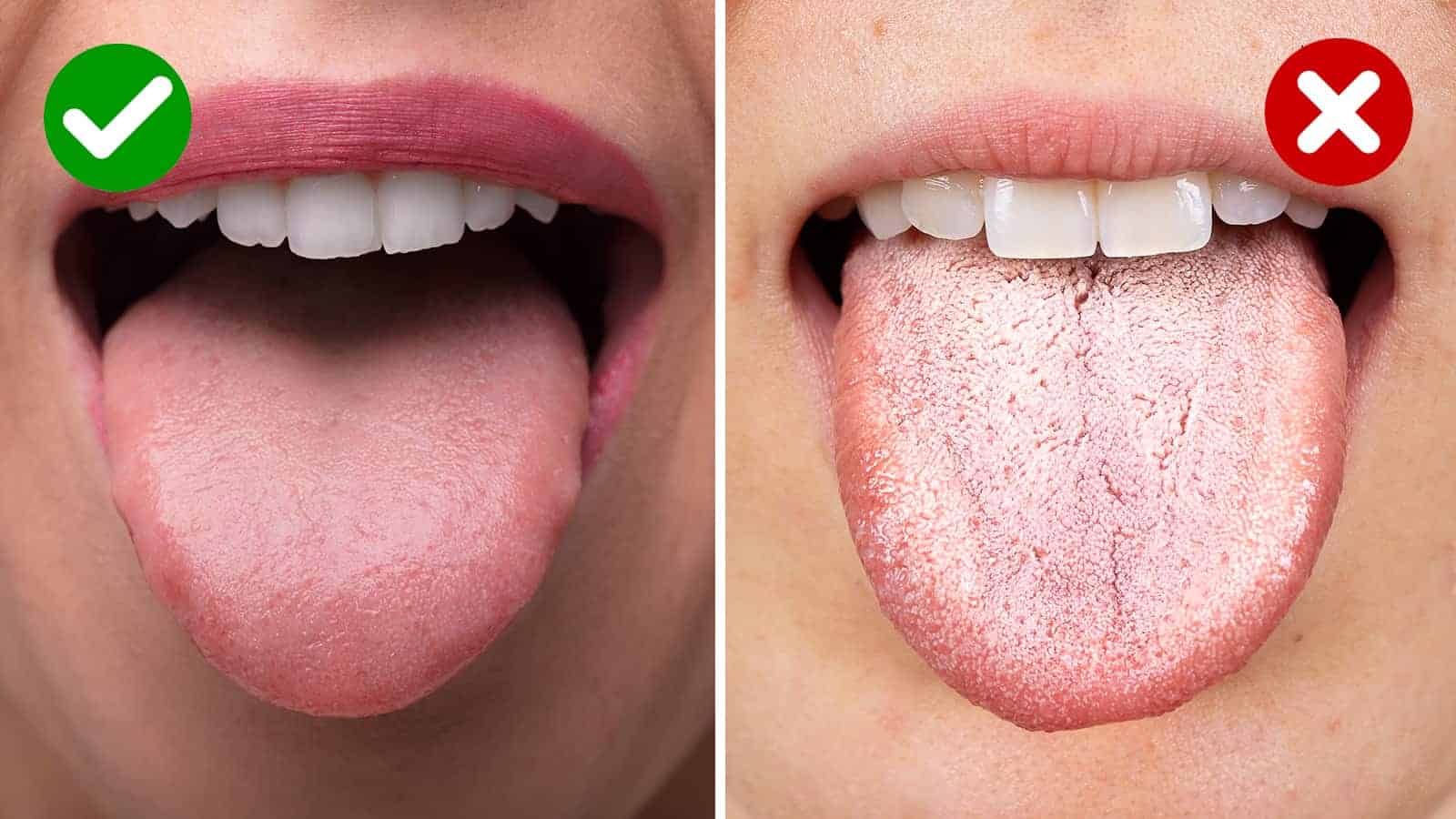Remember when your parents taught you that sticking your tongue out at people was rude? The only exception was when you open your mouth for an oral examination. If the healthcare provider sees a white tongue, what does that say about your general health?
Your tongue is perhaps one of the most amazing muscles in your body. It’s the only muscle group not covered by skin so that you can see and touch it. Also, it’s the only muscle group in your body that moves independently of bones and joints.
Since we are all individuals, not everyone’s tongue is the same. Some people’s tongues may be a little longer and some may be thicker than others. You probably remember from high school biology class that some people can roll their tongues up like a taco while others can’t do this trick.
A thick layer of connective tissue protects the tongue. If you look at the surface of this fantastic muscle, you’ll notice it is coated with a special mucus membrane, says the article. Its root is connected to the back of your throat on the floor of your mouth.
The Three Sections of Your Tongue
While it appears as one organ, your tongue comprises three sections with different jobs. The sides and tip of your tongue are capable of complex movement for speech and primary food digestion. The bumpy surface of the back of your tongue contains many groups of taste buds. You can’t see where the root of your tongue is connected to the floor towards your bottom throat. It keeps the organ stabilized and doesn’t move. These sections work together to provide your sense of taste and food texture.Taste is one of your body’s five senses, and your tongue primarily governs it. See the thin mucus membrane that covers the surface of your tongue? It’s embedded with small bumps called the papilla. Each papilla has one of the following functions:
1. Taste
Many often mistake the raised papilla on their tongue’s surface as taste buds. Most of your papillae contain clusters of taste buds, also called gustatory cells. Each of these has microvilli, which are microscopic hairs that send taste messages to your brain.
Since the human body craves variety, your tongue can identify five taste sensations: sweet, sour, salty, bitter, and savory umami. An article published by The National Library of Medicine shares that all areas of your tongue can detect these tastes. It also debunks the misconception that your language is divided into sections identifying a specific taste sensation.
2. Digestion
When you take a bite of food, your tongue instantly sends messages about flavor, texture, and temperature to your brain. Meanwhile, it has an essential role in primary digestion. This limber group of muscles flips and churns to guide the food to be pulverized by your molars.
Your tongue swishes from side to side to mix the chewed food with digestive enzymes in your saliva. Then, it directs the mixed food to the back of your throat to be swallowed by your esophagus.
3. Speech
If it weren’t for your tongue, speech would be impossible. It collaborates with the mouth, teeth, and throat to form sounds that compose all languages. It provides the many nuances of the world’s dialects, from the lovely rolled “r” sounds to more complex, guttural syllables.
One of the most prevailing myths is the supposed danger of swallowing the tongue, especially during a seizure. Fortunately, this marvel of muscle is secured to the bottom of your mouth by a tough membrane called the lingual frenulum.
You can look in a mirror, lift your tongue, and see how it is attached firmly from the bottom. So, it’s impossible to swallow your tongue.
Consider Your Tongue a Map to Your Health
You can also thank your tongue for being an essential guard against invading bacteria and viruses. At its base toward the back of your throat, you have small glands called tonsils and adenoids. These will often catch the germs and get an infection called tonsillitis.
Fortunately, these glands capture the infection before it spreads inside your body. If you are like many people, you may have had your tonsils and adenoids removed due to chronic diseases. However, other people go through life fine with these protective glands intact.
Have you ever wondered why your healthcare provider always asks you to stick out your tongue and “say ahh?” It’s because they know that the surface of your tongue provides vital clues to your present health. They are looking for any discoloration, such as a white tongue.
If you’re feeling under the weather, you can usually feel an unpleasant coating in your mouth and see it on your tongue in the mirror. It’s one of the countless ways your body is sending distress signals. Your tongue is one of the first areas that show signs of an issue.
When you notice a white layer over your tongue, it doesn’t mean your tongue is turning colors. Infection in your system can cause those bumpy papillae to become inflamed and swollen. Consequently, these swollen papilla trap bacteria and debris, giving the tongue’s surface a fuzzy white appearance.
What Does a White Tongue Mean to Your Wellness?
At a first glance of your tongue, your doctor or dentist gets clues about possible health conditions. Many reasons can cause a white layer on this muscle. Here are five things a white tongue may reveal about your health.
NOTE: While some of these conditions are relatively benign, others are severe or life-threatening. Always receive an accurate diagnosis from a qualified doctor if you see changes in your tongue’s appearance.
1. Thrush
Oral thrush can affect babies, younger children, and adults. Oral thrush forms from an overgrowth of Candida yeast, which is naturally present in the body. When the Candida yeast multiplies rapidly, it can lead to a white fungal infection in the mouth and tongue.
Oral thrush is more common in infants and young children. That’s because they have a less-developed immune system. Thus, the natural balance of microorganisms may be disrupted more easily. However, it can also occur in adults, especially those with weakened immune systems, compromised oral health, or underlying medical conditions that promote yeast overgrowth.
The symptoms of oral thrush typically include the following:
- White or cream-colored patches on the tongue, inner cheeks, roof of the mouth, or throat.
- Redness or soreness in the affected areas.
- Difficulty or discomfort while swallowing or eating.
- Loss of taste or altered taste perception.
- Cracking or redness at the corners of the mouth (in severe cases).
To treat oral thrush naturally at home, try diluted apple cider vinegar. According to studies, apple cider vinegar may have natural antifungal properties that can help combat the Candida yeast. Mix one tablespoon of apple cider vinegar with one cup of warm water. Use this solution as a mouth rinse, swishing it around the mouth for thirty seconds to one minute. Then spit it out. Repeat this process two to three times a day until the symptoms subside.
In addition to home remedies, addressing the underlying factors contributing to oral thrush is vital. Maintaining good oral hygiene is crucial, including regularly brushing teeth, tongue, and gums and flossing. Properly cleaning pacifiers, bottles, and other oral items is essential for babies and young children.
This mouth and throat condition is common in babies and younger children, although adults can get it, too. When the Candida yeast that’s usually present in your body multiplies too quickly, it can present as a white fungal infection in your mouth and tongue. Simple remedies often clear it up quickly.
2. Leukoplakia
Chronic irritation of the mouth may reveal the disorder leukoplakia. Leukoplakia presents as the formation of thickened, white or grayish patches or plaques on the mucous membranes of the tongue, gums, cheeks, and inside of your lips. These patches come from the overgrowth of cells combined with the protein keratin.
Leukoplakia stems from several factors, primarily tobacco use and alcohol consumption. Individuals who smoke or chew tobacco, as well as those who heavily consume alcohol, have a higher likelihood of developing leukoplakia. However, leukoplakia can also occur in people who don’t drink or use tobacco. Further, its exact cause in such cases is not always clear.
While leukoplakia is generally benign, addressing it promptly is crucial. That’s because some leukoplakia lesions can transform malignantly into oral cancer.
Regular dental check-ups are vital for identifying and monitoring this condition. If the dentist or hygienist notices a suspicious leukoplakia lesion, they will order a biopsy to rule out precancerous or cancerous cells. Depending on the results, they may remove or closely monitor the lesion to ensure early detection of any potential cancerous changes.
To reduce the risk of leukoplakia and its potential progression to oral cancer, it is advisable to quit smoking or using tobacco products and to consume alcohol in moderation. Practicing good oral hygiene and maintaining a healthy diet can also contribute to oral health and reduce the risk of developing leukoplakia. Consult a doctor or dentist for a proper evaluation and appropriate management.
3. Geographic Tongue
Geographic tongue, benign migratory glossitis, is a harmless and relatively common rash-like condition affecting the tongue’s surface. It is called “geographic tongue” because its appearance resembles a map. It contains irregular patches or lesions that change in shape, size, and location over time.
The precise cause of geographic tongue is unknown. Still, many believe it relates to various factors, including genetics, immune system abnormalities, and certain triggers such as stress or certain foods. The condition is not contagious and does not pose any serious health risks.
Symptoms of geographic tongue may include the following:
- Irregular, smooth-edged, red or pink patches on the tongue’s surface.
- White or yellowish borders surround the patches.
- Discomfort or sensitivity, mainly when eating spicy or acidic foods or while brushing the tongue.
- The appearance of the patches may change over time, with some patches disappearing and new ones forming elsewhere on the tongue.
Geographic tongue is usually a benign and self-limiting condition. Most cases do not require treatment, and the symptoms often come and go without causing significant problems. However, if the discomfort is persistent or severe, a dentist or doctor may recommend measures to alleviate symptoms.
4. Oral Lichen Planus
Oral lichen planus is a chronic inflammatory condition affecting the mouth and oral mucosa. It typically occurs when the immune system becomes compromised or overreacts, leading to an abnormal immune response in the oral tissues. While the exact cause of oral lichen planus is not fully understood, it is believed to involve a combination of genetic, autoimmune, and environmental factors.
The characteristic feature of oral lichen planus is the development of white, lacy or reticular patches on the tongue, inner cheeks, gums, and other areas inside the mouth. These patches may appear as a thin white coating or have a network-like pattern. In addition to the white patches, individuals with oral lichen planus can experience various symptoms, including painful mouth and tongue lesions, soreness, burning sensations, and discomfort while eating or speaking.
While oral lichen planus is not curable, there are effective management strategies to alleviate symptoms and prevent complications. Treatment aims to control inflammation, reduce discomfort, and promote healing. Treatment options may include:
- Oral hygiene practices: Proper oral hygiene is essential in managing oral lichen planus. Gentle brushing with a soft-bristled toothbrush and using mild, non-irritating toothpaste can help prevent further irritation and infection.
- Avoiding trigger factors: Certain foods, drinks, or oral products may worsen symptoms of oral lichen planus. Identifying and avoiding potential trigger factors such as spicy or acidic foods, alcohol-based mouthwashes, and tobacco products can be beneficial.
- Regular follow-up and monitoring: Ongoing evaluation by a healthcare professional is important to monitor the condition and adjust the treatment plan as needed. Regular dental check-ups are also necessary to ensure optimal oral health and detect any potential complications.
5. Syphilis
This bacterial condition is a severe sexually transmitted disease that can be fatal if not treated. Of all its tell-tale symptoms, a white tongue is usually among them. Of course, your healthcare provider will run tests and compile your medical history before confirming such a precarious diagnosis.
Risk Factors That Can Cause These “White Tongue” Conditions
Several risk factors can make you more vulnerable to developing white patches on your tongue. Many of them are merely an irritation and aren’t life-threatening. If you fit into any of these categories, your tongue may be affected:
- Age: Young children and older seniors are more prone to white patches on their tongues and mouths due to thrush.
- Antibiotics: Sometimes, the antibiotics meant to fight a bacterial infection can become problematic. You may be sensitive to certain antibiotics or use too many. Natural yeast in your mouth can overpopulate and cause an infection and white patches on your tongue.
- Damage: If your tongue is damaged by chewing or other trauma, it may develop white patches. Dentures are notorious for irritating the gums, mouth, and tongue.
- Hypothyroidism: When your thyroid is underactive, it doesn’t produce enough hormones to regulate metabolism. It often affects the color of your tongue.
- Substance abuse: Chewing tobacco, smoking, alcoholism, and drug abuse wreak havoc on your entire body. They can often leave chemical residues in your mouth that show up as pale patches on your tongue.
- Dehydration: Do you drink enough water every day? If not, you can become dehydrated and compromise your health. You may notice a dry mouth, bad breath, and a white tongue.
- Medications: Many medications and cancer treatments can dry your mouth and cause your tongue to get a white coating.
- Poor oral hygiene: Remember to brush and floss your teeth after each meal, or at least twice a day. Also, don’t forget to brush your tongue or use a tongue scraper. If not, bacteria and food particles can cause tooth decay, gum disease, and discolor your tongue.
Final Thoughts on What a White Tongue Means for Your Health
Your tongue may be small, but it plays a significant role in sustaining life and well-being. Take care of it daily with gentle brushings or scraping, and be familiar with its landscape. If you notice lesions, unpleasant tastes, or any odor, it could signal a health condition, even something as small as halitosis. Seek qualified medical advice, as a white tongue reveals an underlying issue.

















 Community
Community

